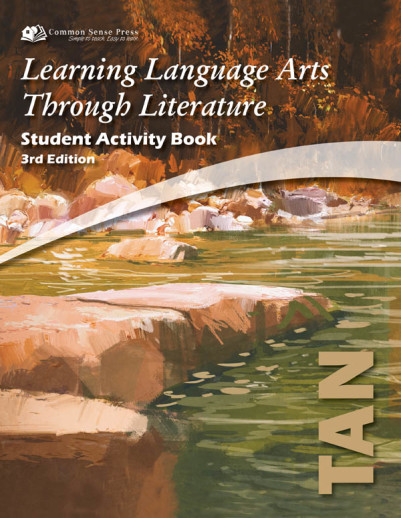We use cookies to make your experience better. To comply with the new e-Privacy directive, we need to ask for your consent to set the cookies. Learn more.
Learning Language Arts Through Literature Tan Student Book (3rd Edition)
The Student Book is consumable and contains some instruction and background information directed to the student as well as generous space to write assignments. The book also contains Enrichment Activities.
The Tan Student Activity Book is the perfect companion for the Tan Teacher Book! Everything in one book: student instruction, a place for writing, and a tool for easy record keeping. Allows for more independent work, a BONUS for teachers. The Tan SAB provides Enrichment Activities such as word puzzles, analogies, logic/reasoning activities and more found ONLY in the SAB. (Answers are found in The Teacher Book.) Please note: the Student Activity Book cannot be used independently.
Covers grammar (parts of speech, punctuation, capitalization, prefixes/suffixes, synonyms, clauses, subject/verb agreement and much more), vocabulary, reading skills (autobiographies, comprehension, foreshadowing, point of view, identifying plot points, irony, mood, choral reading and more), spelling skills, penmanship, research and study skills, composition (advertisements, character sketches, business letters, dialogue, outlines, paragraphs, poetry, summaries, thesis statements and much more), and higher order thinking skills. Includes passages from many popular works of literature as well as four full length. book studies. Passages from: "The Taming of the Shrew," Carry On, Mr. Bowditch, Bambi, "The Eagle," Little House in the Big Woods, Story of a Bad Boy, Prince Caspian, Ivanhoe, King of the Wind, Wheel on the School, "Jest Fore Christmas," Swiss Family Robinson, Swallows and Amazons, Kidnapped, Robinson Crusoe, Wind in the Willows, Caddie Woodlawn, Gettysburg Address, Where the Red Fern Grows, Railway Children, House at Pooh Corner, Anne of Green Gables "Crow and the Pitcher," Little Women, Invincible Louisa, and "The Undecided Man."
The full length books studied in this level include: Carry On Mr. Bowditch, The Bronze Bow, Big Red, and The Horse and His Boy. You can purchase these novels as part of the Complete Package with the Teacher and Student books, buy them separately, or source them from a local library.
3rd edition has been reorganized with three lessons replaced.


I used this curriculum 2 years ago with an older child. I need to replace the student workbook to reuse the set I already have. This is our 3rd consecutive year using LLATL as a homeschool family.…
After using LLATL for 15 years and with all of my 7 children, I wouldn’t use anything else. It is thorough and comprehensive.
I have been very happy with the other levels of Learning Language Arts through Literature that I have purchased.
I was looking for a complete language arts curriculum and this seemed like a good fit.